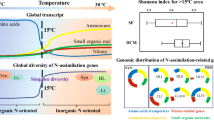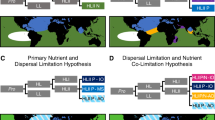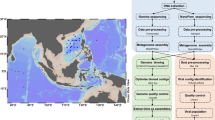Abstract
The globally abundant marine Cyanobacteria Prochlorococcus and Synechococcus share many physiological traits but presumably have different evolutionary histories and associated phylogeography. In Prochlorococcus, there is a clear phylogenetic hierarchy of ecotypes, whereas multiple Synechococcus clades have overlapping physiologies and environmental distributions. However, microbial traits are associated with different phylogenetic depths. Using this principle, we reclassified diversity at different phylogenetic levels and compared the phylogeography. We sequenced the genetic diversity of Prochlorococcus and Synechococcus from 339 samples across the tropical Pacific Ocean and North Atlantic Ocean using a highly variable phylogenetic marker gene (rpoC1). We observed clear parallel niche distributions of ecotypes leading to high Pianka’s Index values driven by distinct shifts at two transition points. The first transition point at 6°N distinguished ecotypes adapted to warm waters but separated by macronutrient content. At 39°N, ecotypes adapted to warm, low macronutrient vs. colder, high macronutrient waters shifted. Finally, we detected parallel vertical and regional single-nucleotide polymorphism microdiversity within clades from both Prochlorococcus and Synechococcus, suggesting uniquely adapted populations at very specific depths, as well as between the Atlantic and Pacific Oceans. Overall, this study demonstrates that Prochlorococcus and Synechococcus have shared phylogenetic organization of traits and associated phylogeography.
Similar content being viewed by others
Log in or create a free account to read this content
Gain free access to this article, as well as selected content from this journal and more on nature.com
or
References
Flombaum P, Gallegos JL, Gordillo RA, Rincón J, Zabala LL, Jiao N, et al. Present and future global distributions of the marine Cyanobacteria Prochlorococcus and Synechococcus. Proc Natl Acad Sci USA. 2013;110:9824–9.
Moore LR, Rocap G, Chisholm SW. Physiology and molecular phylogeny of coexisting Prochlorococcus ecotypes. Nature. 1998;393:464–7.
Ahlgren NA, Rocap G, Chisholm SW. Measurement of Prochlorococcus ecotypes using real-time polymerase chain reaction reveals different abundances of genotypes with similar light physiologies. Environ Microbiol. 2006;8:441–54.
Zinser ER, Johnson ZI, Coe A, Karaca E, Veneziano D, Chisholm SW. Influence of light and temperature on Prochlorococcus ecotype distributions in the Atlantic Ocean. Limnol Oceanogr. 2007;52:2205–20.
Martiny AC, Tai APK, Veneziano D, Primeau F, Chisholm SW. Taxonomic resolution, ecotypes and the biogeography of Prochlorococcus. Environ Microbiol. 2009;11:823–32.
Rusch DB, Martiny AC, Dupont CL, Halpern AL, Venter JC. Characterization of Prochlorococcus clades from iron-depleted oceanic regions. Proc Natl Acad Sci USA. 2010;107:16184–9.
Malmstrom RR, Rodrigue S, Huang KH, Kelly L, Kern SE, Thompson A, et al. Ecology of uncultured Prochlorococcus clades revealed through single-cell genomics and biogeographic analysis. ISME J. 2013;7:184–98.
West NJ, Lebaron P, Strutton PG, Suzuki MT. A novel clade of Prochlorococcus found in high nutrient low chlorophyll waters in the South and Equatorial Pacific Ocean. ISME J. 2011;5:933–44.
Huang S, Wilhelm SW, Harvey HR, Taylor K, Jiao N, Chen F. Novel lineages of Prochlorococcus and Synechococcus in the global oceans. ISME J. 2012;6:285–97.
Johnson ZI, Zinser ER, Coe A, McNulty NP, Woodward EMS, Chisholm SW. Niche partitioning among Prochlorococcus ecotypes along ocean-scale environmental gradients. Science. 2006;311:1737–40.
Fuller NJ, Marie D, Vaulot D, Post AF, Scanlan DJ. Clade-specific 16S ribosomal DNA oligonucleotides reveal the predominance of a single marine Synechococcus clade throughout a stratified water column in the Red Sea. Appl Environ Microbiol. 2003;69:2430–43.
Zwirglmaier K, Jardillier L, Ostrowski M, Mazard S, Garczarek L, Vaulot D, et al. Global phylogeography of marine Synechococcus and Prochlorococcus reveals a distinct partitioning of lineages among oceanic biomes. Environ Microbiol. 2008;10:147–61.
Zwirglmaier K, Heywood JL, Chamberlain K, Woodward EMS, Zubkov MV, Scanlan DJ. Basin-scale distribution patterns of picocyanobacterial lineages in the Atlantic Ocean. Environ Microbiol. 2007;9:1278–90.
Mella-Flores D, Mazard S, Humily F, Partensky F, Mahé F, Bariat L, et al. Is the distribution of Prochlorococcus and Synechococcus ecotypes in the Mediterranean Sea affected by global warming? Biogeosciences Discuss. 2011;8:4281–330.
Post AF, Penno S, Zandbank K, Paytan A, Huse SM, Welch DM. Long term seasonal dynamics of Synechococcus population structure in the Gulf of Aqaba, northern Red Sea. Front Microbiol. 2011;2:131.
Gutiérrez-Rodríguez A, Slack G, Daniels EF, Selph KE, Palenik B, Landry MR. Fine spatial structure of genetically distinct picocyanobacterial populations across environmental gradients in the Costa Rica Dome. Limnol Oceanogr. 2014;59:705–23.
Sohm JA, Ahlgren NA, Thomson ZJ, Williams C, Moffett JW, Saito MA, et al. Co-occurring Synechococcus ecotypes occupy four major oceanic regimes defined by temperature, macronutrients and iron. ISME J. 2016;10:333–45.
Ting CS, Rocap G, King J, Chisholm SW. Phycobiliprotein genes of the marine photosynthetic prokaryote Prochlorococcus: evidence for rapid evolution of genetic heterogeneity. Microbiology. 2001;147:3171–82.
Moore LR, Post AF, Rocap G, Chisholm SW. Utilization of different nitrogen sources by the marine cyanobacteria Prochlorococcus and Synechococcus. Limnol Oceanogr. 2002;47:989–96.
Moore LR, Ostrowski M, Scanlan DJ, Feren K, Sweetsir T. Ecotypic variation in phosphorus-acquisition mechanisms within marine picocyanobacteria. Aquat Microb Ecol. 2005;39:257–69.
Scanlan DJ, Ostrowski M, Mazard S, Dufresne A, Garczarek L, Hess WR, et al. Ecological genomics of marine picocyanobacteria. Microbiol Mol Biol Rev. 2009 Jun;73:249–99.
Martiny AC, Treseder K, Pusch G. Phylogenetic conservatism of functional traits in microorganisms. ISME J. 2013;7:830–8.
Mazard S, Ostrowski M, Partensky F, Scanlan DJ. Multi-locus sequence analysis, taxonomic resolution and biogeography of marine Synechococcus. Environ Microbiol. 2012;14:372–86.
Bergsland KJ, Haselkorn R. Evolutionary relationships among Eubacteria, Cyanobacteria, and Chloroplasts: evidence from the rpoC1 gene of of Anabaena sp. strain PCC 7120. J Bacteriol. 1991;173:3446–55.
Toledo G, Palenik B. Synechococcus diversity in the California Current as seen by RNA polymerase (rpoC1) gene sequences of isolated strains. Appl Environ Microbiol. 1997;63:4298–303.
Karl DM, Tien G. MAGIC: a sensitive and precise method for measuring dissolved phosphorus in aquatic environments. Limnol Oceanogr. 1992;37:105–16.
Lomas MW, Burke AL, Lomas DA, Bell DW, Shen C, Dyhrman ST, et al. Sargasso Sea phosphorus biogeochemistry: an important role for dissolved organic phosphorus (DOP). Biogeosciences . 2010;7:695–710.
Bostrom KH, Simu K, Hagstrom A, Riemann L. Optimization of DNA extraction for quantitative marine bacterioplankton community analysis. Limnol Oceanogr Methods. 2004;2:365–73.
Tai V, Palenik B. Temporal variation of Synechococcus clades at a coastal Pacific Ocean monitoring site. ISME J. 2009;3:903–15.
Andrews S. FastQC: a quality control tool for high throughput sequence data. [Internet]. 2010. Available from: www.bioinformatics.babraham.ac.uk/projects/fastqc/
Caporaso JG, Kuczynski J, Stombaugh J, Bittinger K, Bushman FD, Costello EK, et al. QIIME allows analysis of high-throughput community sequencing data. Nat Publ Gr. 2010;7:335–6.
Camacho C, Coulouris G, Avagyan V, Ma N, Papadopoulos J, Bealer K, et al. BLAST + : architecture and applications. BMC Bioinform. 2009;10:421.
Paradis E, Claude J, Strimmer K. APE: analyses of phylogenetics and evolution in R language. Bioinformatics. 2004;20:289–90.
Felsenstein J. PHYLIP (Phylogeny Inference Package) version 3.69. Department of Genome Sciences, University of Washington, Seattle: Distributed by the author; 2005. http://evolution.genetics.washington.edu/phylip.html.
Schlitzer R. Interactive analysis and visualization of geoscience data with Ocean Data View. Comput Geosci. 2002;28:1211–8.
Larkin AA, Blinebry SK, Howes C, Lin Y, Loftus SE, Schmaus CA, et al. Niche partitioning and biogeography of high light adapted Prochlorococcus across taxonomic ranks in the North Pacific. ISME J. 2016;10:1555–67.
Urbach E, Scanlan DJ, Distel DL, Waterbury JB, Chisholm SW. Rapid diversification of marine picophytoplankton with dissimilar light-harvesting structures inferred from sequences of Prochlorococcus and Synechococcus (cyanobacteria). J Mol Evol. 1998;46:188–201.
Pianka ER. The structure of lizard communities. Annu Rev Ecol Syst. 1973;4:53–74.
Eren AM, Morrison HG, Lescault PJ, Reveillaud J, Vineis JH, Sogin ML. Minimum entropy decomposition: unsupervised oligotyping for sensitive partitioning of high-throughput marker gene sequences. ISME J. 2014;9:968–79.
Lozupone C, Knight R. UniFrac: a new phylogenetic method for comparing microbial communities. Appl Environ Microbiol. 2005;71:8228–35.
Kembel SW, Cowan PD, Helmus MR, Cornwell WK, Morlon H, Ackerly DD, et al. Picante: R tools for integrating phylogenies and ecology. Bioinformatics. 2010;26:1463–4.
Oksanen J, Blanchet F, Kindt R, Legendre P, Minchin P, O’Hara R, et al. Vegan: community ecology package. R package version 2.0-10. [Internet]. Vol. 1, R package version. 2013. Available from: http://cran.r-project.org
Berube PM, Biller SJ, Kent AG, Berta-Thompson JW, Roggensack SE, Roache-Johnson KH, et al. Physiology and evolution of nitrate acquisition in Prochlorococcus. ISME J. 2015;9:1195–207.
Larkin MA, Blackshields G, Brown NP, Chenna R, McGettigan PA, McWilliam H, et al. Clustal W and Clustal X version 2.0. Bioinformatics. 2007;23:2947–8.
Ludwig W, Strunk O, Westram R, Richter L, Meier H, Yadhukumar A, et al. ARB: a software environment for sequence data. Nucleic Acids Res. 2004;32:1363–71.
Fitzwater SE, Coale KH, Gordon RM, Johnson KS, Ondrusek ME. Iron deficiency and phytoplankton growth in the equatorial Pacific. Deep Sea Res Part II Top Stud Oceanogr. 1996;43:995–1015.
Farrant GK, Doré H, Cornejo-Castillo FM, Partensky F, Ratin M, Ostrowski M, et al. Delineating ecologically significant taxonomic units from global patterns of marine picocyanobacteria. Proc Natl Acad Sci USA. 2016;113:E3365–74.
Ahlgren NA, Noble A, Patton AP, Roache-johnson K, Robinson D, Mckay C, et al. The unique trace metal and mixed layer conditions of the Costa Rica upwelling dome support a distinct and dense community of Synechococcus. Limnol Oceanogr. 2014;59:2166–84.
Ting CS, Rocap G, King J, Chisholm SW. Cyanobacterial photosynthesis in the oceans: the origins and significance of divergent light-harvesting strategies. Trends Microbiol. 2002;10:134–42.
Hutchinson GE. The paradox of the plankton. Am Nat. 1961;95:137–45.
Larkin AA, Martiny AC. Microdiversity shapes the traits, niche space, and biogeography of microbial taxa. Environ Microbiol Rep. 2017;9:55–70.
Wu J, Sunda W, Boyle EA, Karl DM. Phosphate depletion in the western North Atlantic. Ocean Sci. 2000;289:759–62.
Kashtan N, Roggensack SE, Berta-Thompson JW, Grinberg M, Stepanauskas R, Chisholm SW. Fundamental differences in diversity and genomic population structure between Atlantic and Pacific Prochlorococcus. ISME J 2017;11:1997–2011.
Martiny AC, Huang Y, Li W. Occurrence of phosphate acquisition genes in Prochlorococcus cells from different ocean regions. Environ Microbiol. 2009;11:1340–7.
Martiny AC, Kathuria S, Berube PM. Widespread metabolic potential for nitrite and nitrate assimilation among Prochlorococcus ecotypes. Proc Natl Acad Sci USA. 2009;106:10787–92.
Delmont TO, Eren AM. Linking pangenomes and metagenomes: the Prochlorococcus metapangenome. PeerJ. 2018;6:e4320.
Kent AG, Dupont CL, Yooseph S, Martiny AC. Global biogeography of Prochlorococcus genome diversity in the surface ocean. ISME J. 2016;10:1856–65.
Acknowledgements
We thank Bradford Hawkins for help with the niche overlap analysis, David Karl and Ken Doggett for help with flow cytometry during the NH1418 cruise, Frédéric Partensky and David Scanlan for sharing rpoC1 sequences, and Sophie Mazard for sharing the multi-locus alignment. AGK was supported by the National Science Foundation Graduate Research Fellowship Program (DGE-1321846) and ACM was supported by the National Science Foundation grants (OCE-0928544, OCE-1046297, and OCE-1559002).
Author contributions
SEB, CM, JSH, MWL, and ACM, acquired data. SEB, CM, JSH, and MWL performed the experiments. AGK and ACM analyzed the data. AGK, CM, AAL, MWL, and ACM wrote the paper.
Author information
Authors and Affiliations
Corresponding author
Ethics declarations
Conflict of interest
The authors declare that they have no conflict of interest.
Electronic supplementary material
Rights and permissions
About this article
Cite this article
Kent, A.G., Baer, S.E., Mouginot, C. et al. Parallel phylogeography of Prochlorococcus and Synechococcus. ISME J 13, 430–441 (2019). https://doi.org/10.1038/s41396-018-0287-6
Received:
Revised:
Accepted:
Published:
Issue date:
DOI: https://doi.org/10.1038/s41396-018-0287-6
This article is cited by
-
Spatial and Temporal Variation of Synechococcus Abundance and Diversity in the Yellow Sea
Ocean Science Journal (2025)
-
Global scale phylogeography of functional traits and microdiversity in Prochlorococcus
The ISME Journal (2023)
-
Ecological mechanisms and current systems shape the modular structure of the global oceans’ prokaryotic seascape
Nature Communications (2023)
-
Differential global distribution of marine picocyanobacteria gene clusters reveals distinct niche-related adaptive strategies
The ISME Journal (2023)
-
Microdiversity characterizes prevalent phylogenetic clades in the glacier-fed stream microbiome
The ISME Journal (2022)



